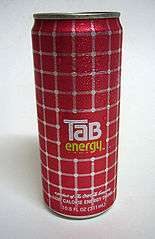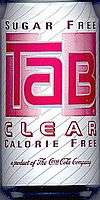Tab (soft drink)
|
The Tab logo as of 2008[1] | |
| Type | Soft drink |
|---|---|
| Manufacturer | The Coca-Cola Company |
| Country of origin | United States |
| Introduced | 1963 |
| Flavor | Diet cola |
| Variants | Tab Clear, Tab X-Tra, Tab Energy |
| Related products | Diet Coke, Coke Zero |
Tab (stylized as TaB) is a diet cola soft drink produced by The Coca-Cola Company, introduced in 1963. The soda was popular throughout the 1960s and 1970s, and several variations were made, including Tab Clear as well as caffeine-free versions.
As a result of studies in the early 1970s linking saccharin, Tab's main sweetener, with bladder cancer in rats, the United States Congress mandated warning labels on products containing the sweetener. The label requirement was later repealed when no evidence was found linking saccharin with cancer in humans.
After its introduction in 1982, Diet Coke quickly replaced Tab as the Coca-Cola Company's most popular diet cola, although Tab still retained a loyal following. Approximately 3 million cases were sold in the United States in 2008.
History
Tab was introduced as a diet drink in 1963.[2] Tab was created by Coca-Cola after the successful sales and marketing of Diet Rite cola, owned by The Royal Crown Company;[3] previously, Diet Rite had been the only sugarless soda on the market. Tab was marketed to consumers who wanted to "keep tabs" on their weight.[2][4]
Coca-Cola's marketing research department used its IBM 1401 computer to generate a list of over 185,000 four-letter words with one vowel, adding names suggested by the company's own staff; the list was stripped of any words deemed unpronounceable or too similar to existing trademarks.[5] From a final list of about twenty names, "Tabb" was chosen, influenced by the possible play on words, and shortened to "Tab" during development. Packaging designer Robert Sidney Dickens gave the name the capitalization pattern ("TaB") used in the logo as well as creating a new bottle design for the soft drink.[6]
Tab has been reformulated several times. It was initially sweetened with cyclamate. After the Food and Drug Administration (FDA) issued a ban on cyclamate in 1969, sodium saccharin was used. Studies in laboratory rats during the early 1970s linked saccharin with the development of bladder cancer. As a result, the United States Congress mandated that further studies of saccharin be performed and required that all food containing saccharin bear a label warning that the sweetener had been shown to cause cancer in laboratory animals. In the absence of further evidence that saccharin caused cancer in humans, the substance was delisted in 2000 from the U.S. National Toxicology Program’s Report on Carcinogens; this led to the repealing of the warning label requirements for products containing saccharin.[7] In December 2010, the United States Environmental Protection Agency removed saccharin from its list of hazardous substances.[8]
At the height of its popularity, the Tab name was briefly extended to other diet soft drinks, including Tab Lemon-Lime, Tab Black Cherry, Tab Ginger Ale, Tab Root Beer and Tab Orange.
Other variants of Tab have appeared over the years:
- Caffeine Free Tab was introduced in the 1980s with little fanfare and disappeared soon afterward.
- In 1992, Coca-Cola released Tab Clear in the U.S., Australia and UK. It was withdrawn after less than a year.
- Tab Energy is an energy drink released in early 2006 that uses a different recipe than Tab cola.
Tab's popularity began to decline in 1982 with the introduction of Diet Coke, although Tab retained something of a cult following in the United States, where customers purchased about 3 million cases in 2008.[4] According to the Coca-Cola Company, in 2012 Tab was being sold in the countries of the Southern African Customs Union (Botswana, Lesotho, Namibia, South Africa, Swaziland), Spain, the U.S. Virgin Islands and the United States.[2]
Tab products
 Tab cola bottle
Tab cola bottle Tab Energy
Tab Energy Tab Clear
Tab Clear
Other Tab products
References
- ↑ Capsule (Firm) (2008). Design Matters: Packaging 01: An Essential Primer for Today's Competitive Market. Beverly, Massachusetts: Rockport Publishers. p. 146. ISBN 1592533426. OCLC 191024079.
- 1 2 3 "Product Descriptions: Tab". The Coca-Cola Company. Archived from the original on 26 June 2012.
- ↑ Siegel, Benjamin (June 2006). "Sweet Nothing—The Triumph of Diet Soda". American Heritage. Archived from the original on 21 June 2006.
- 1 2 "Cult sodas with a history: Tab". Fortune. October 2009.
- ↑ Atlanta Magazine, May 1962.
- ↑ "The TaB bottle". Beach Packaging Design. 29 November 2012.
- ↑ "Artificial Sweeteners and Cancer". National Cancer Institute.
- ↑ "Removal of Saccharin from the Lists of Hazardous Constituents and Hazardous Wastes under RCRA and from the List of Hazardous Substances under CERCLA". United States Environmental Protection Agency. Archived from the original on 29 October 2015.
External links
- Tab brand information on Coca-Cola website
- Ryan, Ted (7 February 2013). "A Sweet Celebration: TaB Commemorates Golden Anniversary on Valentines Day". Coca-ColaCompany.com. Archived from the original on 8 March 2013. Retrieved 2013-03-08.
- New Yorker article on high profile Tab fans
